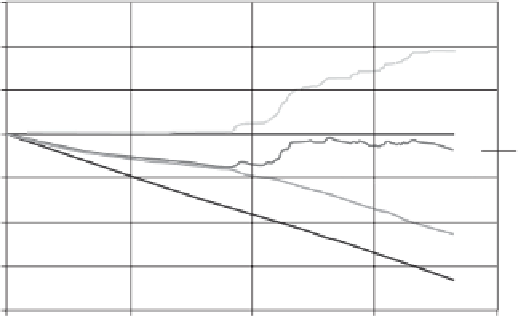Environmental Engineering Reference
In-Depth Information
1.0
Limiting point
0.8
0.6
0.4
0.2
Wilting point
0.0
10
100
1000
10,000
Soil suction, kPa
Figure 6.53
PLF versus soil suction.
1.5
Rainfall = 0.953
Poorly graded
gravel with sand
and silt
1.0
0.5
Runoff = 0.001
0.0
Net flux = 0.179
−
0.5
−
1.0
AE =
−
1.135
Net evaporation =
179 mm
−
1.5
PE =
−
1.659
−
2.0
0
100
200
300
400
Time, days
Figure 6.54
Net infiltration computed after ground surface moisture flux has been applied to
soil-atmospheric model.
The soil-atmospheric model must be solved on an elapsed
time scale that might be on the order of a few minutes. Each
day is modeled as a series of time steps and the time scale is
continued for the entire year. However, one year may not be
sufficient for design purposes in some cases (e.g., the cover
system). Rather, it may be necessary to perform these calcu-
lations for as much as 10 years or more. Needless to say, the
design of soil cover systems is computationally demanding
even without consideration of two- and three-dimensional
geometries. As well, the high nonlinearity of the partial dif-
ferential moisture flow equation makes convergence of the
solution a challenge.
The net effect of the components discussed above is called
the “net infiltration” at the soil surface. Infiltration at the
bottom of a soil cover system is commonly referred to as
“deep infiltration”; however, other terms are also used. The
magnitude of deep infiltration provides an indication of the
amount of water that is likely to pass below the cover sys-
tem into the underlying materials. Needless to say, there are
many assumptions and extensive calculations that go into
the estimation of moisture infiltration.
6.4 CHALLENGES OF NUMERICAL MODELING
GROUND SURFACE MOISTURE FLUX
CONDITIONS
Shackelford (2005) presented a summary of some of the
current and future environmental issues of special interest
to cover systems. The issues mentioned were (1) long-term
performance of waste containment systems, (2) alternative
barriers or covers (i.e., alternative to clay covers) and bar-
rier materials, (3) innovative barriers (covers) and barrier
materials, (4) forms of waste materials, (5) significance of
biological waste processes, (6) the role of numerical mod-
eling in cover design, and (7) professional identity. Of the
mentioned issues, it is the role of numerical modeling as it
relates to cover systems that is of primary interest in the
application of unsaturated soil mechanics.















Search WWH ::

Custom Search